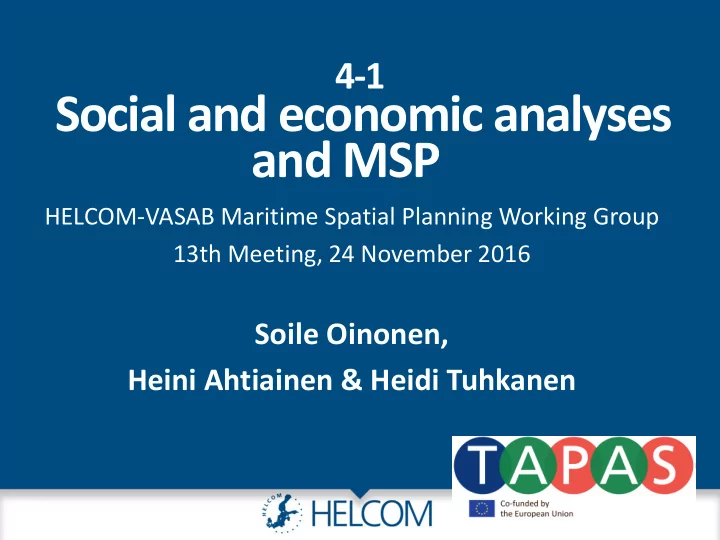

4-1 Social and economic analyses and MSP HELCOM-VASAB Maritime Spatial Planning Working Group 13th Meeting, 24 November 2016 Soile Oinonen, Heini Ahtiainen & Heidi Tuhkanen
Action requested The Meeting is invited to • take note of the information, • exchange information on how countries deal with socio-economic analysis including socio- economic impact assessments in MSP, • discuss possible involvement of the HELCOM- VASAB MSP WG in the future joint development as well as use of social and economic analysis.
Background: 2013 HELCOM Ministerial meeting ○ ”…to initiate or intensify the work to attribute economic value to marine and coastal ecosystem services and their contribution to societal, cultural and ecological well- being…” ○ ”…to incorporate the emerging environmental economics knowledge as well as socio-economic analysis in the work of HELCOM…” ○ ”…cooperate with institutions having leading expertise on economic and social analysis of the use of the Baltic Sea and of the cost of degradation of the marine environment…”
HELCOM HOLAS II & social and economic analyses • HELCOM Second Holistic Assessment of the Ecosystem Health of the Baltic Sea (2014– 2018) – Baltic Sea Action Plan & MSFD reporting • MSFD calls for economic and social analyses – Use of marine waters (UMW) Article 8 –Initial assessment – Cost of degradation (CoD) – Cost-effectiveness analysis (CEA) Article 13 – Programme of Measures – Cost-benefit analysis (CBA)
HELCOM Economic and Social Analyses (ESA) network • Since September 2015 • 3 workshops, 1 project & 1 project application • Concept for regional economic analyses to support HOLAS II & MSFD • Use of Marine Waters Analysis • Cost of Degradation analysis • Linkages to existing research projects (BONUS, FP7) http://helcom.fi/helcom-at-work/groups/state-and-conservation/economic-and-social-analyses-(esa)-network
Concept ?
Use of marine waters (UMW) • Human activities and sectors using marine waters • Description of economic importance and benefits derived from use of marine waters (e.g. production value, value added (profits), number of employees) • Future trends of activities based on national strategies • Mixed approach – Focus on marine water accounting approach (statistics), complemented by ecosystem service approach (non- market values)
Use of marine waters: sectors • Prioritised sectors – the related human activities are creating significant pressure – those deriving significant benefit from the use of marine waters, and/or – those that are dependent on the environmental state of the Baltic Sea. • Extraction of living resources, aquaculture, tourism and leisure activities, energy production, transport
UMW: Using existing tools and data Sector/activity Gross value Employment Depend on Pressure on Expected added in (number environ- environ- trend of million EUR employed) mental state mental state activities FI EE FI EE Extraction of Fish and shellfish 17868 9147 1817 2046 yes yes tbd living resources harvesting Source: STECF 2015. The 2015 Annual Economic Report on the EU Fishing Fleet (STECF 15-07) (link). Data available: All EU states in the Baltic Sea, information by country, 2013 (some 2008-2013). Combination of Baltic Sea Pressure Index and existing statistics • Spatial economic data?
Cost of Degradation (CoD) • Economic benefits forgone if Good Environmental Status (GES) is not reached • Step-by-step approach for CoD analysis – Use of existing peer reviewed literature – Flexible to account for new studies
Example: eutrophication Country Cost of degradation Population (18-80 Cost of degradation (€/person/year, 2015 years old) in millions (M€/year, 2015 euros) euros) in 2015* Denmark 29 – 37 4.28 125 – 158 Estonia 21 – 30 1.011 21 – 31 Finland 42 – 46 4.151 176 – 189 Germany 25 – 28 64.164 1572 – 1781 Latvia 5 – 6 1.553 8 – 9 Lithuania 9 – 10 2.267 19 – 22 Poland 12 – 13 29.789 368 – 383 90.787 Russia 11 – 12 1028 – 1129 Sweden 7.316 60 – 92 440 – 674 205 3760 – 4380 Total * Eurostat, except Russia: Russian Federation Federal State Statistics Service. Russian population includes the population who is over 15 years old in Western Russia, i.e. Central, Southern, North Western, Ural and Volga federal districts. Value estimates in purchasing power parity adjusted 2015 euros. Source: Ahtiainen et al. 2014. Benefits of meeting nutrient reduction targets for the Baltic Sea – a contingent valuation study in the nine coastal states. Journal of Environmental Economics and Policy 3(3):278-305. 11/24/2016 11
Added value from the network • Common understanding of the concepts and co-development of approaches and methods – External project funding • Coordinate and supplement the use of economic data and indicators • Knowledge sharing on ongoing and planned work • Regional focus on the economics of the marine protection
Added value of regional ESA • Enhances comparability of data and approaches across countries and supports national work potentially • Useful for developing methods and approaches for the national analyses and can provide data for national work that are comparable among the countries. • Enhance the consistency of the economic and social analyses in the Baltic Sea region, especially in the long run.
Synergy with the MSP • ESA network has broad skills that are applicable to economic analyses relevant for the MSP • ESA analyses reveal the (relative) importance of marine uses and ecosystem services in economic and social terms • Highlight hidden environmental and ecosystem service values
Synergy with the MSP cont. • Reveal trade-offs (and synergies) between marine uses, activities and ecosystem services • Enhance public participation in the planning (valuation of ecosystem services) • Enable comparisons of the benefits and costs of alternative marine spatial planning solutions
Potential next steps • A review of national progress, available information and information gaps – Fulfill the information gaps • Use of existing tools in assessing how the marine environment would develop in the future as marine uses change, thus contributing to the analysis of MSP scenarios.
Thank you!
Recommend
More recommend